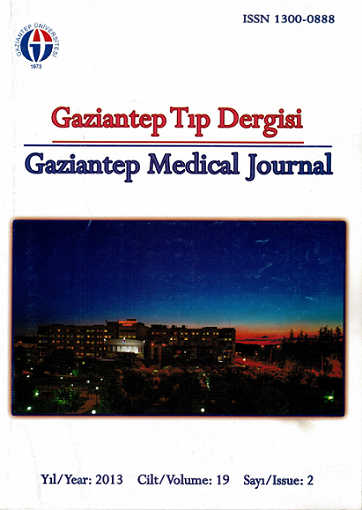A cause of a periodic pulmonary edema: consumption of licorice syrup
Dönemsel bir akciğer ödemi nedeni: meyan şerbeti içimi
DOI:
https://doi.org/10.5455/GMJ-30-2013-134Keywords:
Edema, emergency service, hypertension, licorice, pulmonaryAbstract
The aim of this study is to evaluate patients with pulmonary edema due to periodical consumption of licorice syrup. The patients who consumed licoric syrup in recently and admitted to emergency department with dyspnea were examined comprehensive during Ramadan in 2011 and 2012. They underwent routine biochemical investigations, chest X-rays, and electrocardiogram assessment. In addition, cardiac function was examined using echocardiography. Information relating to patients detected with interstitial pulmonary edema was recorded, and all recorded data were evaluated. The number of patients diagnosed with pulmonary edema in the 2-month period was 82. Thirty two of these patients (39%) had a history of consumption of licorice syrup. At first assessment, the mean systolic blood pressure of the study participants was 160.5±18.3 mmHg (130-220), and diastolic blood pressure was 92.6 ±9.8 mmHg (75-120). The mean sodium level was 143.2±3.47 mmol/L (134-149), potassium was 3.4±0.3 mmol/L (3,1-4,3), urea was 56.1±18.9 mg/dl (26-114), and creatinine was 1.1±0.27 mg/dL (0,6-1,8). The injection fraction of 12 patients was under 40%. Of the study participants, 19 were hospitalized in a coronary intensive care unit, while 13 were treated with an emergency department. All study participants recovered and were subsequently discharged from hospital. Excessive consumption of licorice syrup is a hidden cause of pulmonary edema and/or hypertension and therefore should be investigated for in individuals diagnosed with these conditions.
Metrics
References
Omar HR, Komarova I, El-Ghonemi M, Fathy A, Rashad R, Abdelmalak HD, et al. Licorice abuse: time to send a warning message. Ther Adv Endocrinol Metab 2012;3(4):125-38.
Imtıaz K.E. Sweet root, bitter pill: liquorice-induced hyperaldosteronism QJM 2011;104(12):1093–5
Hamidon BB, Jeyabalan V. Exogenously-induced apparent hypermineralocorticoidism associated with ingestion of “asam boi”. Singapore Med J 2006;47(2):156-8.
Farese RV Jr, Biglieri EG, Shakelton CH, Irony I, GomezFontes R. Licorice-induced hypermineralocorticoidism. N Engl J Med 1991;325(17):1223-7.
Hasegawa J, Suyama Y, Kinugawa T, Morisawa T, Kishimoto Y. Echocardiographic findings of the heart resembling dilated cardiomyopathy during hypokalemic myopathy due to licoriceinduced pseudoaldosteronism. Cardiovasc Drugs Ther 1998;12(6):599–600.
Chamberlain TJ. Licorice poisoning, pseudoaldosteronism, and heart failure. JAMA 1970;213(8):1343.
Chamberlain JJ, Abolnik IZ. Pulmonary edema following a licorice binge. West J Med 1997;167(3):184-5.
Meltem AC, Figen C, Nalan MA, Mahir K, Sebnem B, Mehlika I, et al. A hypokalemic muscular weakness after licorice ingestion: a case report. Cases J 2009;2:8053.
Yasue H, Itoh T, Mizuno Y, Harada E. Severe hypokalemia, rhabdomyolysis, muscle paralysis, and respiratory impairment in a hypertensive patient taking herbal medicines containing licorice. Intern Med 2007;46(9):575-8.
van den Bosch AE, van der Klooster JM, Zuidgeest DM, Ouwendijk RJ, Dees A. Severe hypokalaemic paralysis and rhabdomyolysis due to ingestion of licorice. Neth J Med 2005;63(4):146–8.
Lin SH, Yang SS, Chau T, Halperin ML. An unusual cause of hypokalemic paralysis: chronic licorice ingestion. Am J Med Sci 2003;325(3):153-6.
Elinav E, Chajek-Shaul T. Licorice consumption causing severe hypokalemic paralysis. Mayo Clin Proc 2003;78(6):767–8.
Russo S, Mastropasqua M, Mosetti MA, Persegani C, Paggi A. Low doses of liquorice can induce hypertension encephalopathy. Am J Nephrol 2000;20(2):145–8.
Yorgun H, Aksoy H, Sendur MA, Ates AH, Kaya EB, Aytemir K, et al. Brugada syndrome with aborted sudden cardiac death related to liquorice-induced hypokalemia. Med Princ Pract 2010;19(6):485–9.
Ruiz-Granados ES, Shouls G, Sainsbury C, Antonios T. A salty cause of severe hypertension. BMJ Case Rep. 2012 Feb 25;2012.
Asl MN, Hosseinzadeh H. Review of pharmacological effects of glycyrrhiza sp. and its bioactive compounds. Phytother Res 2008;22(6):709-24.
Downloads
Published
How to Cite
Issue
Section
License
Copyright (c) 2023 European Journal of Therapeutics

This work is licensed under a Creative Commons Attribution-NonCommercial 4.0 International License.
The content of this journal is licensed under a Creative Commons Attribution-NonCommercial 4.0 International License.


















